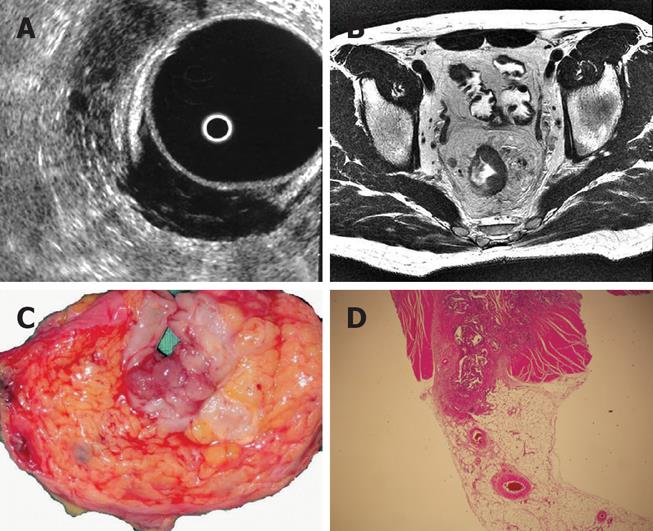Copyright
©2008 The WJG Press and Baishideng.
World J Gastroenterol. Jun 14, 2008; 14(22): 3504-3510
Published online Jun 14, 2008. doi: 10.3748/wjg.14.3504
Published online Jun 14, 2008. doi: 10.3748/wjg.14.3504
Figure 1 A: MRI demonstrates a large tumor passing through the muscularis propria and invading the mesorectal fatty tissue within very close proximity to the mesorectal fascia; lymph nodes are also present; The MRI prediction was a T4 tumor; B: This was predicted as a T3 tumor by ERUS examination; C: Macroscopic specimen shows that the tumor has already filled all the mesorectal fatty tissue but the mesorectal fascia is still intact; D: Pathological examination reveals that this is a T3 stage tumor.
Figure 2 A: ERUS shows the tumor invading the muscularis propria which can be regarded as a T2 tumor.
A lymph node is also seen; B: MRI clearly demonstrates that the tumor is confined to the muscularis propria and does not invade the mesorectal fatty tissue. Lymph nodes are also seen; C: Macroscopic specimen reveals the tumor does not extend to the mesorectal fat; D: Pathology confirms that this is a T2 stage tumor.
Figure 3 A: ERUS examination shows the tumor extend to the mesorectal fat by passing beyond the muscularis propria.
A lymph node is also seen; B: MRI defines the tumor as violating the muscularis propria and extending to the mesorectal fatty tissue. Lymph nodes are seen; C: Operation specimen confirms mesorectal invasion; D: Pathology specimen demonstrates tumor cells invading the mesorectum which is indicative of a T3 tumor.
Figure 4 A: ERUS shows perirectal fat invasion of the tumor and predicts it as T3; B: MRI demonstrates that the tumor is not invading the mesorectal fatty tissue and is confined to the rectum which is considered as a T2 tumor.
The lymph nodes are also present in the mesorectal fatty tissue; C: Operation specimen reveals that the tumor does not extend beyond the muscularis propria; D: Pathology confirms that this is a T2 stage tumor.
-
Citation: Halefoglu AM, Yildirim S, Avlanmis O, Sakiz D, Baykan A. Endorectal ultrasonography
versus phased-array magnetic resonance imaging for preoperative staging of rectal cancer. World J Gastroenterol 2008; 14(22): 3504-3510 - URL: https://www.wjgnet.com/1007-9327/full/v14/i22/3504.htm
- DOI: https://dx.doi.org/10.3748/wjg.14.3504












